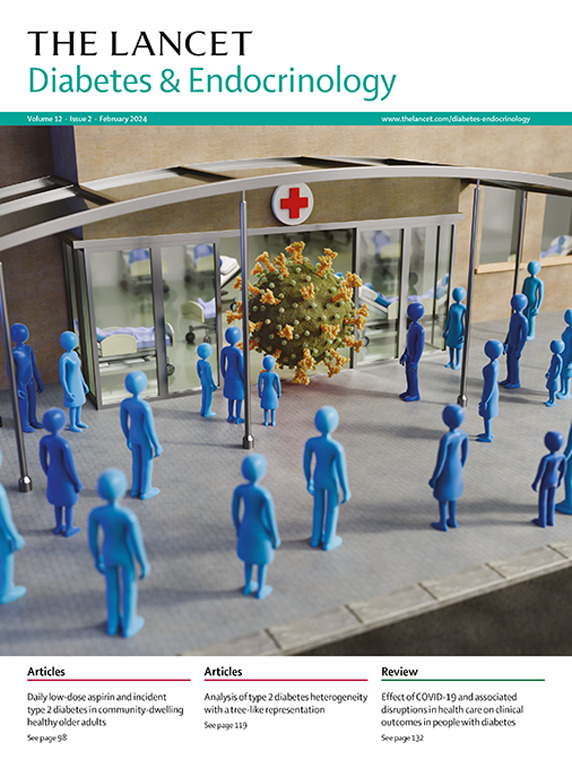Thyroid eye disease (Graves' orbitopathy): clinical presentation, epidemiology, pathogenesis, and management
IF 41.8
1区 医学
Q1 ENDOCRINOLOGY & METABOLISM
引用次数: 0
Abstract
Thyroid eye disease (TED; also known as Graves' orbitopathy), causes swollen extraocular muscles and orbital fat. Mechanistically, TED involves lid retraction, oedema and redness of the eyelids and conjunctiva, proptosis, diplopia, and optic neuropathy. Investigation of TED involves assessment of disease activity (inflammation) and disease severity. TED is predominantly mild in 77% of cases, moderate-to-severe in 22%, and rarely sight-threatening in 1% of patients. While most patients with TED have Graves' hyperthyroidism, up to 5% are euthyroid or even hypothyroid. Risk factors include male sex, older age, smoking, diabetes, hypercholesterolaemia, duration of hyperthyroidism, radioactive iodine therapy, and the presence of thyrotropin receptor (TSHR) antibodies (detectable in more than 95% of patients and directly related to TED activity and severity). Genetic immunisation of mice with TSHR, but not with insulin-like growth factor-1 receptor (IGF-1R), provides a reliable animal model of TED, demonstrating that TSHR is the primary autoantigen in the disease. Crosstalk between TSHR and IGF-1R occurs via a β-arrestin scaffold. Teprotumumab, a human monoclonal antibody that blocks IGF-1R without binding to TSHR, has been shown to significantly improve outcomes in moderate-to-severe TED, including greater proptosis reduction compared with intravenous methylprednisolone. However, its disadvantages include side effects (eg, hearing loss in 30% of patients), a high cost, and a high relapse rate. Therefore, intravenous steroids remain the treatment of choice in many parts of the world. Tocilizumab, which blocks the interleukin-6 receptor, is an effective treatment option for patients with TED who are steroid-resistant. This Review further discusses alternative medications, surgical treatments, local measures, and the importance of quality-of-life assessments and multidisciplinary care.甲状腺眼病(Graves眼病):临床表现、流行病学、发病机制和治疗
甲状腺眼病;也被称为格雷夫斯眼病),引起眼外肌肉肿胀和眼窝脂肪。从机理上讲,TED包括眼睑收缩、眼睑和结膜水肿和发红、眼球突出、复视和视神经病变。TED的调查包括疾病活动性(炎症)和疾病严重程度的评估。在77%的病例中,TED主要是轻度的,在22%的病例中是中度至重度的,在1%的患者中很少有视力威胁。虽然大多数TED患者患有格雷夫斯甲状腺功能亢进症,但高达5%的患者甲状腺功能正常甚至甲状腺功能减退。危险因素包括男性、年龄较大、吸烟、糖尿病、高胆固醇血症、甲状腺功能亢进持续时间、放射性碘治疗和促甲状腺激素受体(TSHR)抗体的存在(在95%以上的患者中可检测到,与TED活动和严重程度直接相关)。对患有TSHR而非胰岛素样生长因子-1受体(IGF-1R)的小鼠进行遗传免疫,提供了可靠的TED动物模型,证明TSHR是该疾病的主要自身抗原。TSHR和IGF-1R之间的串扰通过β抑制蛋白支架发生。Teprotumumab是一种阻断IGF-1R而不与TSHR结合的人单克隆抗体,已被证明可显著改善中度至重度TED的预后,包括与静脉注射甲基强的松龙相比更大的预后降低。然而,它的缺点包括副作用(例如,30%的患者听力丧失),费用高,复发率高。因此,静脉注射类固醇仍然是世界上许多地方的治疗选择。Tocilizumab是一种阻断白细胞介素-6受体的药物,对于类固醇抵抗的TED患者来说是一种有效的治疗选择。本综述进一步讨论了替代药物、手术治疗、局部措施以及生活质量评估和多学科护理的重要性。
本文章由计算机程序翻译,如有差异,请以英文原文为准。
求助全文
约1分钟内获得全文
求助全文
来源期刊

The Lancet Diabetes & Endocrinology
ENDOCRINOLOGY & METABOLISM-
CiteScore
61.50
自引率
1.60%
发文量
371
期刊介绍:
The Lancet Diabetes & Endocrinology, an independent journal with a global perspective and strong clinical focus, features original clinical research, expert reviews, news, and opinion pieces in each monthly issue. Covering topics like diabetes, obesity, nutrition, and more, the journal provides insights into clinical advances and practice-changing research worldwide. It welcomes original research advocating change or shedding light on clinical practice, as well as informative reviews on related topics, especially those with global health importance and relevance to low-income and middle-income countries. The journal publishes various content types, including Articles, Reviews, Comments, Correspondence, Health Policy, and Personal Views, along with Series and Commissions aiming to drive positive change in clinical practice and health policy in diabetes and endocrinology.
 求助内容:
求助内容: 应助结果提醒方式:
应助结果提醒方式:


